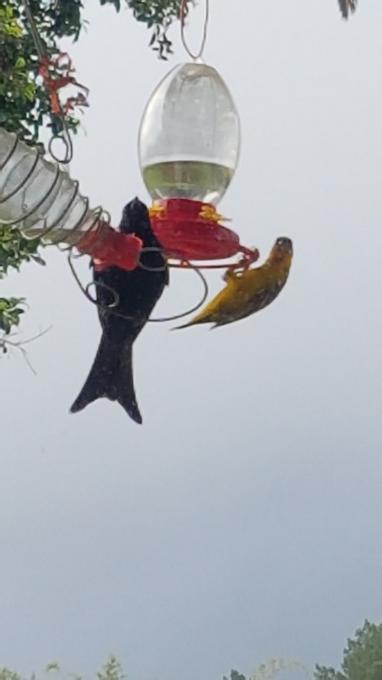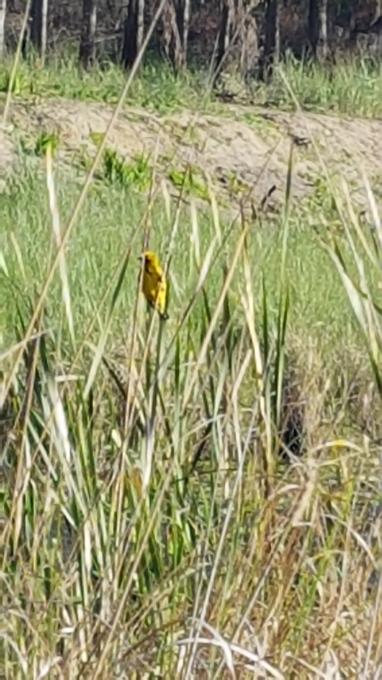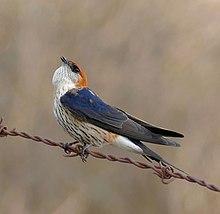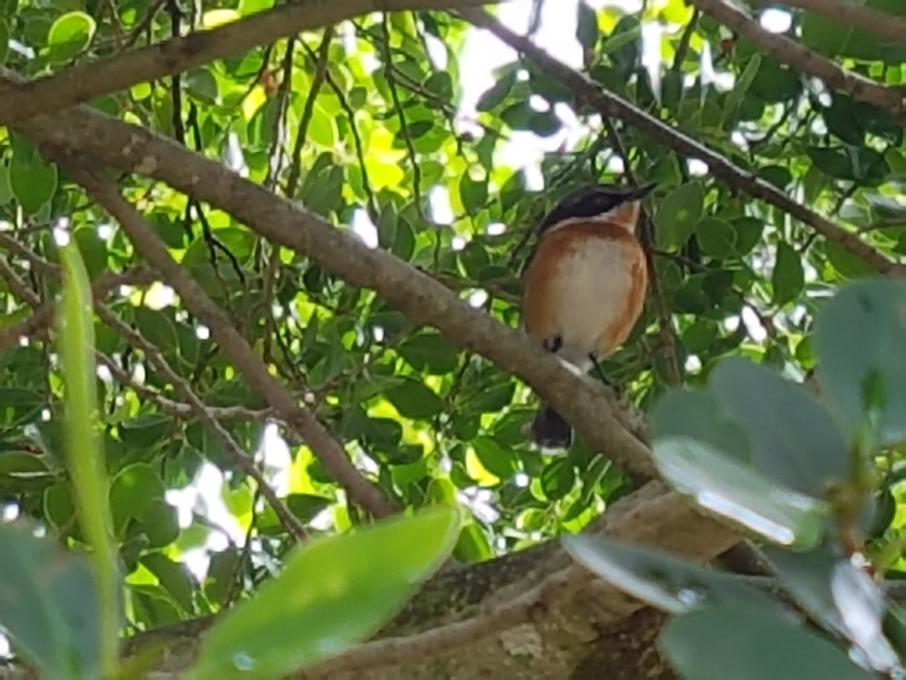Janet
Forum Replies Created
Viewing 7 posts - 1 through 7 (of 7 total)
-
JanetParticipant
 Activity 1 & 4: I love watching birds, therefore we have various different feeders in our garden, seed feeders, nectar feeders and a fruit table. We also have a bird bath which we clean out regularly, it is lovely to watch the Cape Robins, Olive Thrush and Bul buls taking a bath. I took part on the 12 May in Ebird global count day and since then I have become pretty addicted to watching birds, I have decided to buy myself a DSLR Camera, in order to be able to take close up photographs of birds.
Thank you for giving me this new found inspiration to observe birds even more closely than I did before, everytime I hear a bird I look up to try and spot it, I am now able to identify at least 6 birds by hearing their song or call. in reply to: Activities: Helping Birds in Your World #728706
Activity 1 & 4: I love watching birds, therefore we have various different feeders in our garden, seed feeders, nectar feeders and a fruit table. We also have a bird bath which we clean out regularly, it is lovely to watch the Cape Robins, Olive Thrush and Bul buls taking a bath. I took part on the 12 May in Ebird global count day and since then I have become pretty addicted to watching birds, I have decided to buy myself a DSLR Camera, in order to be able to take close up photographs of birds.
Thank you for giving me this new found inspiration to observe birds even more closely than I did before, everytime I hear a bird I look up to try and spot it, I am now able to identify at least 6 birds by hearing their song or call. in reply to: Activities: Helping Birds in Your World #728706 -
JanetParticipant
 Activity 1: This is on the edge of a dam, with lots of reeds all around, the most prolific bird are the weavers, "Cape Weavers" & "Southern Masked Weavers". There are many weavers nests all along the edge of the water, hanging from the reeds. Apart from the weavers, there are" Yellow-billed ducks" and they forage for plants and invertebrates, other birds are the "Eurasian Moorhen" and the "Levaillant Cisticola" The Levaillant Cisticola is a tiny little bird with a high pitched chirp, it eats short-horned grasshoppers, beetles, weevils & flies . I have seen a pair of "White-faced Whistling-Ducks" which are uncommon in my area, a striking duck and apparently feeds at night, they dive down to obtain their food, mainly feed on underwater tubers, also molluscs and small aquatic animals.
Vineyards - The "Cape Francolin" walks between the vine rows , the male can weigh up to 980g they eat invertebrates and fallen fruit, then the "Southern Fiscal", perches on the wire holding up the vines and then swoops down on insects or small vertebrates they then impale their prey on a thorn or piece of barbed wire and tear off pieces of flesh. Then there are two types of the waxbills, the "Common Waxbill" & "Swee Waxbill" tiny finches with short wings, normally in flocks found on the vines and on the ground around the vines, they feed on grass seeds and insects especially during the breeding season. in reply to: Activities: Exploring Bird Habitats #728066
Activity 1: This is on the edge of a dam, with lots of reeds all around, the most prolific bird are the weavers, "Cape Weavers" & "Southern Masked Weavers". There are many weavers nests all along the edge of the water, hanging from the reeds. Apart from the weavers, there are" Yellow-billed ducks" and they forage for plants and invertebrates, other birds are the "Eurasian Moorhen" and the "Levaillant Cisticola" The Levaillant Cisticola is a tiny little bird with a high pitched chirp, it eats short-horned grasshoppers, beetles, weevils & flies . I have seen a pair of "White-faced Whistling-Ducks" which are uncommon in my area, a striking duck and apparently feeds at night, they dive down to obtain their food, mainly feed on underwater tubers, also molluscs and small aquatic animals.
Vineyards - The "Cape Francolin" walks between the vine rows , the male can weigh up to 980g they eat invertebrates and fallen fruit, then the "Southern Fiscal", perches on the wire holding up the vines and then swoops down on insects or small vertebrates they then impale their prey on a thorn or piece of barbed wire and tear off pieces of flesh. Then there are two types of the waxbills, the "Common Waxbill" & "Swee Waxbill" tiny finches with short wings, normally in flocks found on the vines and on the ground around the vines, they feed on grass seeds and insects especially during the breeding season. in reply to: Activities: Exploring Bird Habitats #728066 -
JanetParticipant
 Activity 1: Building nests This is a nest that is currently being built/weaved by a "Southern Masked Weaver" I was watching the weaver carry strips of bamboo leaves to build his nest, extremely fascinating how these little birds can build such intricate nests only with their beaks. I could not get close enough to take a photo while the Masked Weaver was weaving and I did not want to frighten him, so while he was away collecting more building material I took a close up shot of his nest. in reply to: Activities: Noticing Behaviors #727868
Activity 1: Building nests This is a nest that is currently being built/weaved by a "Southern Masked Weaver" I was watching the weaver carry strips of bamboo leaves to build his nest, extremely fascinating how these little birds can build such intricate nests only with their beaks. I could not get close enough to take a photo while the Masked Weaver was weaving and I did not want to frighten him, so while he was away collecting more building material I took a close up shot of his nest. in reply to: Activities: Noticing Behaviors #727868 -
JanetParticipantActivity 2: Birds that do and do not migrate in my area.
- I live in the Western Cape in South Africa, there are not many birds that migrate that live in my area. I have researched most of the birds and they are all mostly endemic to South Africa namely:
- Malachite sunbird
- Cape Batis
- Cape Bulbul
- Olive Woodpecker.
- Some birds that migrate to South Africa:
- Greater striped swallow is the only bird that visits our area and has built a nest against our house in previous years. It breeds in South Africa, it is migratory wintering further north in Angola & Tanzania

- White stork
- Yellow-billed kite
- European bee-eater
- Lesser Kestrel
in reply to: Activities: Different Seasons, Different Birds #727404 -
JanetParticipantActivity 1: I saw a variety of birds, many that i know, especially the Cape Weaver which is very common in our area. I did see 4 birds that I have not seen before. The first bird "White-faced whistling duck" (Dendrocyna viduata) there were two of them sleeping in a standing position on the edge of a dam in the reeds. The 2nd bird I am still not able to identify it is a small stocky bird with a sharp heavy black bill and as I was looking into the sun it was difficult to be sure but I could see tinges of yellow and black - it could of been a cape weaver, but is was much smaller. The 3rd bird "Karoo Prinia" sitting on an electricity wire. The 4th bird "Yellow Canary" also sitting on an electricity wire.in reply to: Activities: Local Bird Exploration #724900
-
JanetParticipant
 Activity 4: The Malachite Sunbird is a slim bodied, nectarivorous bird, although will eat insects, especially when feeding their young. This is a photo taken from my nectar bottle bird feeder, such an electric colourful striking bird, it is a beauty, one of my favourites. The Malachite sunbird has a long down-curved bill, enabling it to nectar feed from flowers or feeders. It seems that this bird's plumage is all one colour, metalic green, but it does have blackish green wings and its belly is an electric teal blue, this bird has a very slender long tail up to 25cm long. This sunbird is found in hilly fynbos areas, feeding off aloes and proteas. It is found in parks and gardens as well. The call is quite distinctive and often I hear the call before I see the bird, and then I start looking up to see where it is, it is a shrill tseep-tseep sound. The chicks are fed by both parents until fledging time, and the chicks will up to a certain time return to the nest to roost. in reply to: Activities: Bird ID Practice #724740
Activity 4: The Malachite Sunbird is a slim bodied, nectarivorous bird, although will eat insects, especially when feeding their young. This is a photo taken from my nectar bottle bird feeder, such an electric colourful striking bird, it is a beauty, one of my favourites. The Malachite sunbird has a long down-curved bill, enabling it to nectar feed from flowers or feeders. It seems that this bird's plumage is all one colour, metalic green, but it does have blackish green wings and its belly is an electric teal blue, this bird has a very slender long tail up to 25cm long. This sunbird is found in hilly fynbos areas, feeding off aloes and proteas. It is found in parks and gardens as well. The call is quite distinctive and often I hear the call before I see the bird, and then I start looking up to see where it is, it is a shrill tseep-tseep sound. The chicks are fed by both parents until fledging time, and the chicks will up to a certain time return to the nest to roost. in reply to: Activities: Bird ID Practice #724740 -
JanetParticipant
 Activity 3 - One of my favourite birds The Cape Batis is a small, stout insect-eating passerine bird in the wattle-eye family. I like this bird because it is secretive, although allows one to get close enough to observe it. in reply to: Activities: Exploring Birds #720584
Activity 3 - One of my favourite birds The Cape Batis is a small, stout insect-eating passerine bird in the wattle-eye family. I like this bird because it is secretive, although allows one to get close enough to observe it. in reply to: Activities: Exploring Birds #720584
Viewing 7 posts - 1 through 7 (of 7 total)
 Activity 1 & 4: I love watching birds, therefore we have various different feeders in our garden, seed feeders, nectar feeders and a fruit table. We also have a bird bath which we clean out regularly, it is lovely to watch the Cape Robins, Olive Thrush and Bul buls taking a bath. I took part on the 12 May in Ebird global count day and since then I have become pretty addicted to watching birds, I have decided to buy myself a DSLR Camera, in order to be able to take close up photographs of birds.
Thank you for giving me this new found inspiration to observe birds even more closely than I did before, everytime I hear a bird I look up to try and spot it, I am now able to identify at least 6 birds by hearing their song or call.
Activity 1 & 4: I love watching birds, therefore we have various different feeders in our garden, seed feeders, nectar feeders and a fruit table. We also have a bird bath which we clean out regularly, it is lovely to watch the Cape Robins, Olive Thrush and Bul buls taking a bath. I took part on the 12 May in Ebird global count day and since then I have become pretty addicted to watching birds, I have decided to buy myself a DSLR Camera, in order to be able to take close up photographs of birds.
Thank you for giving me this new found inspiration to observe birds even more closely than I did before, everytime I hear a bird I look up to try and spot it, I am now able to identify at least 6 birds by hearing their song or call.  Activity 1: This is on the edge of a dam, with lots of reeds all around, the most prolific bird are the weavers, "Cape Weavers" & "Southern Masked Weavers". There are many weavers nests all along the edge of the water, hanging from the reeds. Apart from the weavers, there are" Yellow-billed ducks" and they forage for plants and invertebrates, other birds are the "Eurasian Moorhen" and the "Levaillant Cisticola" The Levaillant Cisticola is a tiny little bird with a high pitched chirp, it eats short-horned grasshoppers, beetles, weevils & flies . I have seen a pair of "White-faced Whistling-Ducks" which are uncommon in my area, a striking duck and apparently feeds at night, they dive down to obtain their food, mainly feed on underwater tubers, also molluscs and small aquatic animals.
Vineyards - The "Cape Francolin" walks between the vine rows , the male can weigh up to 980g they eat invertebrates and fallen fruit, then the "Southern Fiscal", perches on the wire holding up the vines and then swoops down on insects or small vertebrates they then impale their prey on a thorn or piece of barbed wire and tear off pieces of flesh. Then there are two types of the waxbills, the "Common Waxbill" & "Swee Waxbill" tiny finches with short wings, normally in flocks found on the vines and on the ground around the vines, they feed on grass seeds and insects especially during the breeding season.
Activity 1: This is on the edge of a dam, with lots of reeds all around, the most prolific bird are the weavers, "Cape Weavers" & "Southern Masked Weavers". There are many weavers nests all along the edge of the water, hanging from the reeds. Apart from the weavers, there are" Yellow-billed ducks" and they forage for plants and invertebrates, other birds are the "Eurasian Moorhen" and the "Levaillant Cisticola" The Levaillant Cisticola is a tiny little bird with a high pitched chirp, it eats short-horned grasshoppers, beetles, weevils & flies . I have seen a pair of "White-faced Whistling-Ducks" which are uncommon in my area, a striking duck and apparently feeds at night, they dive down to obtain their food, mainly feed on underwater tubers, also molluscs and small aquatic animals.
Vineyards - The "Cape Francolin" walks between the vine rows , the male can weigh up to 980g they eat invertebrates and fallen fruit, then the "Southern Fiscal", perches on the wire holding up the vines and then swoops down on insects or small vertebrates they then impale their prey on a thorn or piece of barbed wire and tear off pieces of flesh. Then there are two types of the waxbills, the "Common Waxbill" & "Swee Waxbill" tiny finches with short wings, normally in flocks found on the vines and on the ground around the vines, they feed on grass seeds and insects especially during the breeding season.  Activity 1: Building nests This is a nest that is currently being built/weaved by a "Southern Masked Weaver" I was watching the weaver carry strips of bamboo leaves to build his nest, extremely fascinating how these little birds can build such intricate nests only with their beaks. I could not get close enough to take a photo while the Masked Weaver was weaving and I did not want to frighten him, so while he was away collecting more building material I took a close up shot of his nest.
Activity 1: Building nests This is a nest that is currently being built/weaved by a "Southern Masked Weaver" I was watching the weaver carry strips of bamboo leaves to build his nest, extremely fascinating how these little birds can build such intricate nests only with their beaks. I could not get close enough to take a photo while the Masked Weaver was weaving and I did not want to frighten him, so while he was away collecting more building material I took a close up shot of his nest. 
 Activity 4: The Malachite Sunbird is a slim bodied, nectarivorous bird, although will eat insects, especially when feeding their young. This is a photo taken from my nectar bottle bird feeder, such an electric colourful striking bird, it is a beauty, one of my favourites. The Malachite sunbird has a long down-curved bill, enabling it to nectar feed from flowers or feeders. It seems that this bird's plumage is all one colour, metalic green, but it does have blackish green wings and its belly is an electric teal blue, this bird has a very slender long tail up to 25cm long. This sunbird is found in hilly fynbos areas, feeding off aloes and proteas. It is found in parks and gardens as well. The call is quite distinctive and often I hear the call before I see the bird, and then I start looking up to see where it is, it is a shrill tseep-tseep sound. The chicks are fed by both parents until fledging time, and the chicks will up to a certain time return to the nest to roost.
Activity 4: The Malachite Sunbird is a slim bodied, nectarivorous bird, although will eat insects, especially when feeding their young. This is a photo taken from my nectar bottle bird feeder, such an electric colourful striking bird, it is a beauty, one of my favourites. The Malachite sunbird has a long down-curved bill, enabling it to nectar feed from flowers or feeders. It seems that this bird's plumage is all one colour, metalic green, but it does have blackish green wings and its belly is an electric teal blue, this bird has a very slender long tail up to 25cm long. This sunbird is found in hilly fynbos areas, feeding off aloes and proteas. It is found in parks and gardens as well. The call is quite distinctive and often I hear the call before I see the bird, and then I start looking up to see where it is, it is a shrill tseep-tseep sound. The chicks are fed by both parents until fledging time, and the chicks will up to a certain time return to the nest to roost.  Activity 3 - One of my favourite birds The Cape Batis is a small, stout insect-eating passerine bird in the wattle-eye family. I like this bird because it is secretive, although allows one to get close enough to observe it.
Activity 3 - One of my favourite birds The Cape Batis is a small, stout insect-eating passerine bird in the wattle-eye family. I like this bird because it is secretive, although allows one to get close enough to observe it.